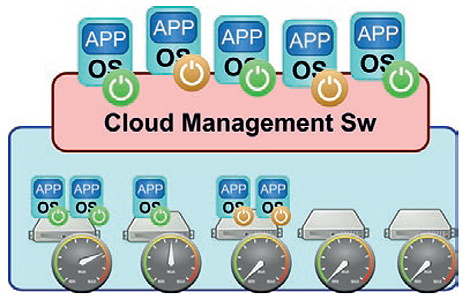 Big cloud providers these days report power "overhead"
(i.e., non-computing energy spent for cooling or power
conversion) has dropped around 10%, hence the next step
for further efficiency will consist in dynamically shaping
power consumption according to actual load.
Big cloud providers these days report power "overhead"
(i.e., non-computing energy spent for cooling or power
conversion) has dropped around 10%, hence the next step
for further efficiency will consist in dynamically shaping
power consumption according to actual load.
Unfortunately, this is not straightforward to achieve in
practice. Consolidation can be used to keep only running
the minimal number of servers to accommodate the sold
capacity. However, it is worth pointing out that the above
relationship should build on actual computation intensity
(i.e., CPU usage) rather than the resource size (mainly,
number of CPUs and amount of RAM), as someone might
be tempted to do. It is undisputable that every interactive
service (excluding therefore intensive computation on large
bulks of data) is subject to large deviations of incoming
requests, with typical hourly, daily, weekly, and even
seasonal periodicity. The so eulogised cloud elasticity is
only effective with the longer timescales, since the time to
technically and, most of all, administratively provisioning
and de-provisioning resources is in the order of days.
LET'S USE POWER STATES FOR VIRTUAL MACHINES!
Waiting for more concrete demonstration of the technical
effectiveness and usability of emerging technologies
like unikernels, real-time resource provisioning remains
a chimera today. As a matter of fact, the deployment of
additional (idle) resources is the only viable solution for
critical business services that require high-availability/QoS
both in case of failure and peaks of workload. That means
cloud users are somehow forced to pay for something that
might only be used occasionally, while the effectiveness of
any energy-efficiency consolidation is partially undermined.
"Let's not put high-performance servers into a permanent
idle state!" was the title of a recent article in this same
magazine1, which debated on the efficiency of low-power
idle states for servers. We would like to continue the
discussion with an additional challenging call: Let's use
power states for virtual machine!
But, what is the meaning of power state (e.g., active,
suspend-to-ram, suspend-to-disk) for a virtual resource?
Well, it cannot directly save energy as happens in real
hardware, but it is an effective trigger for the management
of the underlying physical infrastructure. Basically, it says
that the resource will not be used before it gets resumed.
THE ARCADIA USE CASE FOR ENERGY EFFICIENCY
The ARCADIA project has developed an innovative
framework for development, deployment, and management
of highly-distributed cloud applications. Through policydriven
orchestration, the framework supports life-cycle
operations: re-configuration, horizontal and vertical scaling,
replication, etc. A specific Use Case has been implemented
for energy efficiency, which chases more efficiency by
changing the power state of virtual machines according to
the evolving context. An energy-efficiency module extends
OpenStack, by gathering active VMs together into the
smallest number of servers, and putting all other servers
into suspend-to-ram mode. The project will shortly carry
out functional and performance evaluation for a video
transcoding application.
Contact Details:
Matteo Repetto, CNIT
Email: matteo.repetto@cnit.it
Project web: www.arcadia-framework.eu
Project twitter: @eu_arcadia
1. Cecilia Bonefeld-Dahl, “Let’s not put high-performance servers into a permanent idle state!,” European Energy Innovation, Summer 2017, pp. 32-33.
This project is funded by the EU's H2020 Programme under GA no. 645372